Differentiate biodegradable and non-biodegradable pollutants. Classify the following under the above two categories : DDT, Paper, Cotton, cloth, Plastic
Step-by-Step Solution:
1. Understanding Biodegradable Pollutants:
- Biodegradable pollutants are substances that can be broken down into non-poisonous substances by the action of microorganisms (like bacteria, fungi, etc.).
- These pollutants decompose naturally and do not accumulate in the environment.
2. Understanding Non-Biodegradable Pollutants:
- Non-biodegradable pollutants are substances that cannot be broken down by microorganisms.
- They remain in the environment for a long time, often breaking down into harmful substances rather than non-poisonous ones.
3. Key Differences:
- Biodegradable Pollutants:
- Can be decomposed by microorganisms.
- Do not need to be dumped as they break down naturally.
- Examples include organic waste, paper, cotton, and cloth.
- Non-Biodegradable Pollutants:
- Cannot be decomposed by microorganisms.
- Must be dumped as they persist in the environment.
- Examples include DDT (a pesticide) and plastic.
4. Classification of Given Substances:
- Biodegradable Pollutants:
- Paper
- Cotton
- Cloth
- Non-Biodegradable Pollutants:
- DDT
- Plastic
Summary of Classification:
- Biodegradable: Paper, Cotton, Cloth
- Non-Biodegradable: DDT, Plastic
---
- Biodegradable pollutants are substances that can be broken down into non-poisonous substances by the action of microorganisms (like bacteria, fungi, etc.).
- These pollutants decompose naturally and do not accumulate in the environment.
- Non-biodegradable pollutants are substances that cannot be broken down by microorganisms.
- They remain in the environment for a long time, often breaking down into harmful substances rather than non-poisonous ones.
- Biodegradable Pollutants:
- Can be decomposed by microorganisms.
- Do not need to be dumped as they break down naturally.
- Examples include organic waste, paper, cotton, and cloth.
- Non-Biodegradable Pollutants:
- Cannot be decomposed by microorganisms.
- Must be dumped as they persist in the environment.
- Examples include DDT (a pesticide) and plastic.
- Biodegradable Pollutants:
- Paper
- Cotton
- Cloth
- Non-Biodegradable Pollutants:
- DDT
- Plastic
- Biodegradable: Paper, Cotton, Cloth
- Non-Biodegradable: DDT, Plastic
Topper's Solved these Questions
- OUR ENVIRONMENTBOOK - MBD -HARYANA BOARDCHAPTER - OUR ENVIRONMENTEXERCISE - Long Answer Type Questions
1 Videos
- OUR ENVIRONMENTBOOK - MBD -HARYANA BOARDCHAPTER - OUR ENVIRONMENTEXERCISE - EXAMPLES
153 Videos
- OUR ENVIRONMENTBOOK - MBD -HARYANA BOARDCHAPTER - OUR ENVIRONMENTEXERCISE - Very Short Answer Type Questions
30 Videos
- NEW STYLE MODEL TEST PAPER - 2BOOK - MBD -HARYANA BOARDCHAPTER - NEW STYLE MODEL TEST PAPER - 2EXERCISE - SET - D(SECTION -C ( LIFE SCIENCE ))
11 Videos
Similar Questions
Knowledge Check
The following table summarises the differences between biodegradable and non-biodegradable pollutants. Pick out the wrong diggerences and select the correct answer.
 A(i) and (iv)B(ii) and (iv)C(iii) and (iv)D(ii), (iii) and (iv)
A(i) and (iv)B(ii) and (iv)C(iii) and (iv)D(ii), (iii) and (iv)Unlimited exploitation of nature by man disturbed the delicate ecological balance between the living and non-living components of the biosphere. The unfavourable conditions created by man himself threatened the survival not only of him but also of the entire living organisms on the mother earth. Rehan is an active member of 'Eco club' of his school which is creating environmental awareness amongst the school students, spreading the same in the society and also working hard for preventing environmental degradation of the surroundings. As part of this awareness programme, they are explaining the importance of using different dustbing for biodegradable and non-biodegradable wastes. Generally green duslbing are for biodegradable wastes and blue for non-biodegradable wastes.
In the following groups of materials, which group(s) contains only non-biodegradable items?
(I) Wood, paper, leather
(II) Polythene, detergent, PVC
(III) Plastic, detergent, grass
(IV) Plastic, bakelite, DDTA(III)B(IV)C(I) and (III)D(II) and (IV)Select the non-degradable pollutant(s) from the following
I Plastic
II Organochloride pesticides .
III Heavy metals
IV. Domestic sewageAI and II only are correctBII and III only are correctCl, ll and III are correctDI, II, III and IV are correct
Name any two biodegradable and two non biodegradable pollutants.
View SolutionDifferentiate between biodegradable and non-biodegradable substances with the help of one example each. List two changes in habit that people must adopt to dispose non-biodegradable waste, for saving the environment.
View SolutionDifferentiate between biodegradable and non-biodegradable substances with the help of one example each. List two changes in habit that people must adopt to dispose non-biodegradable waste, for saving the environment.
View SolutionWhich of the following are biodegradable and which non-biodegradable ?
Glass bottle, Paper, Ball point pen refill, Hay, DDT, Wheat, Cake, Wood, Polythene bag, Jute bag, Cotton cloth, Grass, Vegetable peels
View Solution(a) What is meant by non-biodegradable waste materials ? Give two examples of non-biodegradable wastes.
(b) Which of the following materials are biodegradable ?
Animal bones, Iron nails, Plastic mugs, Leather belts, Silver foil
View Solution
